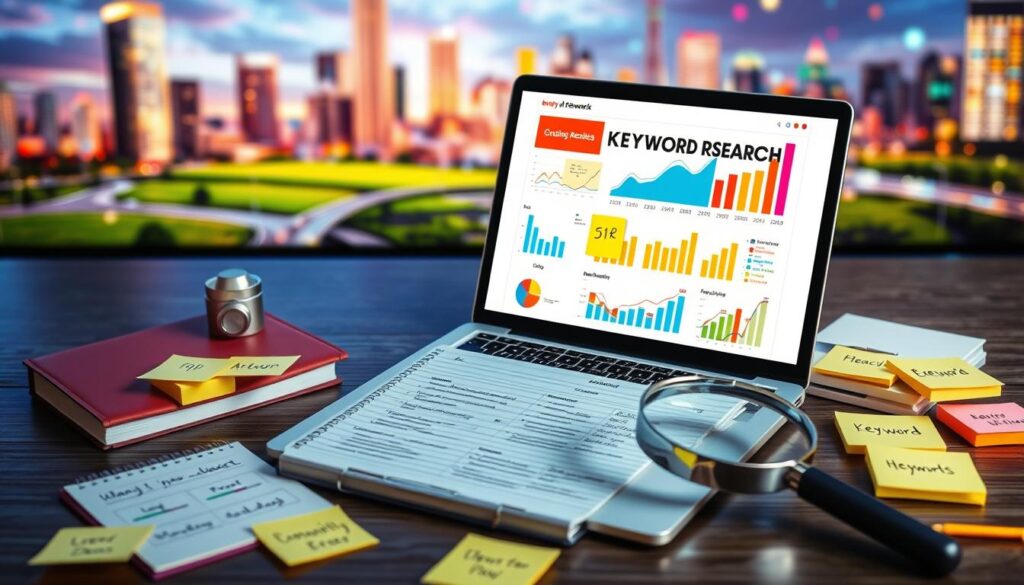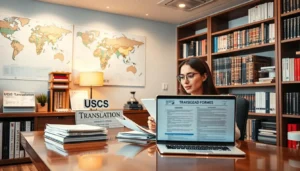On-page optimization plays a key role in boosting your website’s presence in search results. By refining content and optimizing the HTML code, businesses can climb higher in rankings. Experts like Moz and Neil Patel state it’s crucial for good SEO.
It involves improving titles, headings, and images. Also, making content that meets what users are looking for is essential. This leads to better engagement and more website visitors.
Table of Contents
ToggleKey Takeaways
- On-page optimization boosts search engine visibility.
- High-quality content is essential for user engagement.
- Employ effective HTML practices to improve SEO.
- Aligning content with user intent increases traffic.
- Regular updates to your website keep content relevant.
- Utilize analytics to measure on-page performance.
Understanding On-Page Optimization
On-page optimization is about making your website more visible and better for SEO. It includes working on content, HTML tags, URLs, and pictures. Each part is important for where your site appears in search results. If you are looking for the best Website, you can Visit here for more information: 구글 상위노출
Search engines like Google look at many details to understand a webpage. They check if the content matches what people are looking for, if the right keywords are used, and what the overall user experience is like. Good on-page optimization makes visitors happy, reduces bounce rates, and can boost conversions.
Making your site fit what users need is crucial. By creating quality content that matches user searches, you can really up your SEO game. This helps you stand out in a crowded market.
| Optimization Element | Description | Impact on SEO |
|---|---|---|
| Content Quality | Relevant and informative text that engages users. | Boosts search engine ranking by satisfying user queries. |
| HTML Tags | Proper use of title, header, and meta tags. | Helps search engines understand page context. |
| URLs | Descriptive and clean URL structures. | Enhances user navigation and indexing by search engines. |
| Images | Optimized images with appropriate alt text. | Improves load times and accessibility, positively affecting SEO. |
The Importance of Content Optimization
Content optimization is key for effective SEO strategies. It makes your content engaging and informative. This meets search engine requirements.
High-quality content helps drive traffic, keeps visitors on your site, and builds audience trust. Knowing content optimization lets your material connect deeply with readers.
Creating High-Quality Content
It’s important to create top-notch content for your online success. This means articles that are well-researched and stories that grab the audience. Some key aspects include:
- Clear Structure: Use headings, subheadings, and bullet points for easy navigation.
- Relevant Information: Ensure that the content is helpful and answers potential questions from readers.
- Visual Appeal: Integrate images and infographics to enhance readability.
- Engaging Tone: Maintain a friendly and approachable voice throughout the text.
Aligning Content with User Intent
Understanding what your audience is looking for is essential. By providing answers to their needs, your content is more likely to be engaged with and shared. To align content with user intent, consider:
- Identify Common Queries: Research the questions and challenges faced by your target audience.
- Employ Keyword Integration: Use keywords naturally to meet user needs, avoiding keyword stuffing.
- Optimize Content Length: Make sure your content is long enough to cover the topic but remains concise.
Keyword Research Strategies
Mastering keyword research is very important. It helps improve how your pages work. You need to find words and phrases your audience searches for.
This is how you make content that matters to your visitors. It gets them involved and interested.
Identifying Relevant Keywords
Start with tools like Google Keyword Planner and Ahrefs. They help find the right keywords for your area of work. Look at how often people search for these words and how much competition there is.
Choosing keywords with lots of searches can bring more people to your site. But, picking specific ones means your content will really meet what users are looking for.
Using Long-Tail Keywords Effectively
Long-tail keywords are very useful. They are longer than usual, more descriptive, and have less competition. This makes them easier to rank for.
They also help with getting more sales, by reaching users ready to buy. Writing about these detailed searches can make more people see your site in search results. This attracts people who are ready to take action.

| Keyword Type | Search Intent | Competition Level | Conversion Potential |
|---|---|---|---|
| Short-Tail Keywords | Generic | High | Low |
| Relevant Keywords | Informational | Medium | Medium |
| Long-Tail Keywords | Specific | Low | High |
Crafting Effective Meta Tags
Meta tags are key in SEO, helping search engines understand your site. They make users want to visit your page. Knowing how to perfect these helps your visibility and search rankings.
Writing Compelling Meta Titles
Make sure your meta title captures your page’s essence and draws interest. Use keywords to boost your spot in searches. It should be clear, to the point, and interesting.
- Keep meta titles between 50-60 characters.
- Include primary keywords toward the beginning.
- Highlight the unique value of your content.
Optimizing Meta Descriptions for Engagement
Meta descriptions are short summaries that encourage clicks. They need to mix keywords and persuasive language well. This mix helps increase click-through rates.
- Maintain a character limit of 150-160 characters.
- Use active language that compels action.
- Address potential user queries directly.
Good meta tags, both titles and descriptions, help with SEO and the user experience. Aim for text that’s brief, catchy, and mirrors your website’s value.
| Meta Title Characteristics | Meta Description Characteristics |
|---|---|
| 50-60 characters | 150-160 characters |
| Keyword integration | Compelling language |
| Reflects page content | Encourages clicks |
The Role of Header Tags in SEO
Header tags are key in organizing web content. They help structure content, making it easy to read. This is good for both readers and search engines.
Using tags like H1, H2, and H3 correctly can improve readability. Plus, it clearly shows the main and subtopics.
Using H1, H2, and H3 Tags Effectively
Each header tag has its unique role:
- H1 Tag: This is for the page title, highlighting the main keyword. It mirrors what the content is about.
- H2 Tags: These are for section titles. They outline key points and help move through the text smoothly.
- H3 Tags: These are for details under H2 sections. They add more structure.
Structuring Content for Readability
Good structure makes content easy to read. It lets readers find key points fast.
Search engines prefer well-organized content. It makes indexing simpler. Here’s a table showing how header tags help:
| Header Tag | Purpose | Impact on Readability |
|---|---|---|
| H1 | Indicates the main topic | Sets the context for the reader |
| H2 | Organizes main ideas | Enhances navigability |
| H3 | Details subtopics | Facilitates easy scanning |
Image Optimization Techniques
Image optimization is key for a website’s speed and SEO. Optimized images load faster and appear higher in search results. Knowing the best image formats and how to correctly use alt text helps. This makes your site more accessible and widespread.
Choosing the Right Image Formats
It’s important to pick the right image formats. This ensures a good balance between quality and file size. The common formats are:
- JPEG: Great for photos with its good compression.
- PNG: Ideal for graphics needing clarity and transparency.
- GIF: Perfect for simple animations but with limited colors.
- WebP: Offers excellent compression and quality.
Choosing wisely means better optimization. This leads to quicker loading and a better experience for viewers.
Using Alt Text for SEO
Alt text with images is crucial for SEO and accessibility. It describes the images for search engines and screen reader users. Good alt text boosts optimization efforts. When writing alt text, keep these tips in mind:
- Be brief but descriptive about the image’s details.
- Use relevant keywords naturally, avoid stuffing.
- Stay clear and simple, no need for complex terms.
Correct alt text use improves search rankings and adds context. This aids both search engines and users.
| Image Format | Best Use Case | Compression Type |
|---|---|---|
| JPEG | Photographs | Lossy |
| PNG | Graphics with transparency | Lossless |
| GIF | Simple animations | Lossless |
| WebP | High-quality images with smaller sizes | Both Lossy and Lossless |
Improving Site Structure
A great site structure boosts user experience and search engine rankings. It makes sure people can find what they need fast. This makes them happy, so they stay longer. Moreover, a smart URL layout helps search engines and users navigate better.
Creating an Intuitive Navigation System
Here’s how to make navigation easy:
- Simplicity is key: Keep your menu simple and clean.
- Organize by categories: Put similar content together to help users.
- Utilize dropdowns: Use dropdowns for a tidy main menu.
- Include a search bar: A search option improves the experience.
Implementing URL Structure Best Practices
Good URLs are essential for your site’s success. Here’s what to remember when making them:
- Use keywords that show what’s on the page.
- Avoid complicated extras that confuse everyone.
- Keep URLs short; they’re easier to handle.
- Use hyphens to separate words, for clarity.
Enhancing Internal Linking
Internal linking is a key part of helping people navigate a website and improving SEO. By linking your own content wisely, you make your site easier to use. This lets users and search engines understand your site better.
It also brings SEO perks. It boosts older pages’ visibility and spreads authority through your site.
Benefits of Internal Links for SEO
Internal links bring many benefits:
- Improved Site Navigation: Internal links guide users to more of your content, making browsing better.
- Enhanced Page Authority: They spread ranking power across your site, helping hidden pages perform better.
- Better Crawlability: Search engines can more easily crawl your site and spot key pages.
- Contextual Relevance: Using descriptive anchor text gives clues to both visitors and search engines.
Strategies for Effective Internal Linking
To really boost your site’s SEO, follow these linking strategies:
- Use descriptive anchor text for clarity about the linked content.
- Link to relevant pages to keep your content connected.
- Keep internal links per page reasonable, so users aren’t overwhelmed.
- Keep your internal links up to date to stay relevant.
On-Page Optimization Best Practices
To keep up with high search engine rankings, focus on on-page optimization. It helps keep content relevant and engage users.
Regularly Updating Content
Updating content often makes it fresh and interesting. Search engines like websites that stay current. By updating old articles with new information, you encourage users to keep coming back.
Monitoring Performance Metrics
Looking at performance metrics helps understand if a website is doing well. Metrics like organic traffic, bounce rates, and conversion rates show how effective your on-page efforts are. Evaluating these can point out what needs work, helping to serve users better.
Engaging with User Feedback
User feedback is key to making websites better. Listening to users through surveys or comments helps make smart changes. Knowing what users think improves content relevance and increases engagement.

| Practice | Benefit | Impact on SEO |
|---|---|---|
| Content Updates | Keeps information relevant | Improves rankings |
| Monitoring Metrics | Identifies strengths/weaknesses | Enhances decision-making |
| User Feedback | Informs content adjustments | Boosts engagement |
Measuring the Success of Your On-Page Strategies
Knowing how to measure success well is key for improving your on-page tactics. Using the right analytics tools gives you insights into how your website is doing and how users interact with it. By keeping an eye on important metrics, you can spot trends, chances for growth, and things that need to be better.
Utilizing Analytics Tools
Tools like Google Analytics and Bing Webmaster Tools are great for seeing how your on-page work is paying off. They help you keep track of where your traffic comes from, how users behave, and how much they engage. These insights help make smart choices about your content and SEO approach.
Key Metrics to Track
It’s important to focus on certain key metrics for measuring success well. Important metrics to keep an eye on include:
- Organic Traffic: How many visitors you get from search engines shows if your SEO is working.
- Average Session Duration: If people stay longer, it means they’re really getting into your content.
- Page Views: Seeing how many pages people check out tells you if they’re interested in your site.
- Bounce Rate: A lower bounce rate means people find your site relevant and worth exploring.
Keeping tabs on these metrics through analytics tools lets you tweak your strategy to match what users want and how search engines are changing. Being up-to-date with these metrics helps you keep improving your on-page optimization.
| Metric | Description | Importance |
|---|---|---|
| Organic Traffic | Visitors coming from search engines | Indicates effectiveness of SEO efforts |
| Average Session Duration | Time users spend on your site | Reflects user engagement |
| Page Views | Total number of pages viewed | Indicates content interest |
| Bounce Rate | Percentage of visitors leaving after one page | High rates may signal content issues |
Conclusion
On-page optimization is key to SEO success. It helps websites shine online. You need great content, smart keyword use, and to make the most of header tags and links. Each part is vital for good performance and connecting with people.
Keep your website fresh by updating regularly. Also, check how well your on-page strategies are working. Listening to user feedback is important. Plus, watch out for new trends and changes in search engine rules.
By focusing on advanced on-page optimization, you’ll boost your SEO. This improves site visits. More importantly, it makes the user’s experience better. This leads to success in the online world.
FAQ
What is on-page optimization?
On-page optimization makes your website better for search engines and people. It works on your site’s content, HTML, and structure. The goal is to make it easy to use and right for search terms.
Why is content optimization important?
Making great content is key. It keeps people on your site and follows SEO rules. This helps your website do well in search results.
How do I conduct keyword research?
Use tools like Google Keyword Planner and Ahrefs for keyword research. They find keywords people search for. Aim for long-tail keywords. They are specific, less competitive, and improve conversions.
What role do meta tags play in SEO?
Meta tags like titles and descriptions tell search engines and users what your page is about. Good meta tags can make more people click on your site from search results.
How should I structure header tags for SEO?
Use header tags (H1, H2, H3) to show your content’s layout. H1 should have the main keyword. H2 and H3 tags break the content into sections. This helps users and search engines navigate your site.
What is the importance of image optimization?
Optimizing images speeds up your site and improves the experience. It helps rank in image searches. Use the right formats and alt text for SEO and to help users with disabilities.
How can I improve my site’s structure?
Make navigation easy to help users find what they need quickly. Use keywords in URLs for clear navigation. This benefits users and search engines.
What are the benefits of internal linking?
Internal links improve navigation and help search engines understand your site. They boost older content’s visibility and spread authority across your website.
How often should I update my content?
Update your content regularly to keep it relevant. This draws people back to your site and enhances your SEO efforts.
What metrics should I track to measure on-page success?
Track organic traffic, bounce rates, session time, and page views. Tools like Google Analytics and Search Console help monitor these. They guide your optimization.













